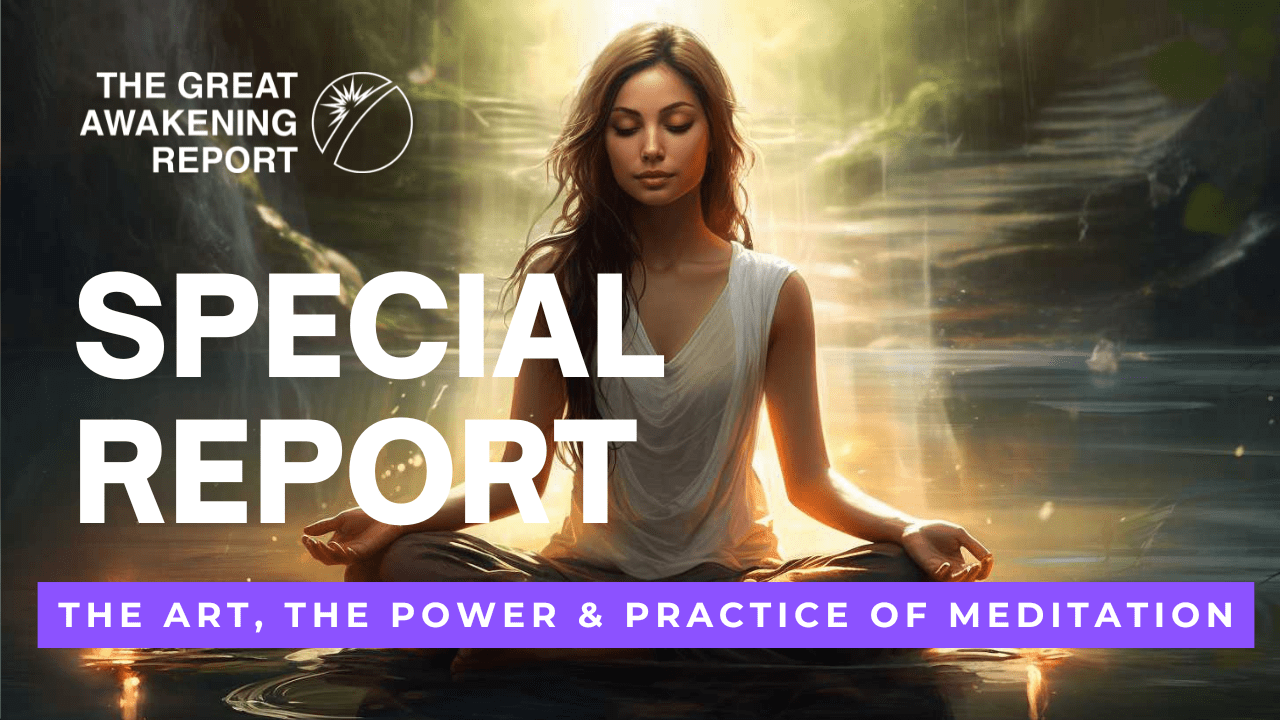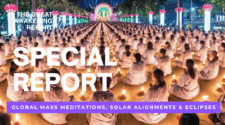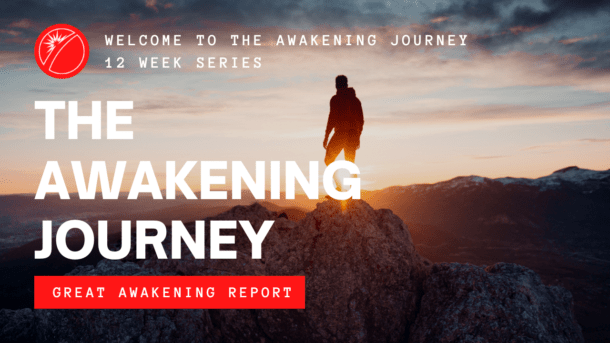Published Date: March 25th, 2024 | Updated, 2024 💢
SPECIAL REPORT
TRUTH///AWAKENING///DISCLOSURE
THE ART, THE POWER & PRACTICE OF MEDITATION
Seeking the Path Inside to a New Reality
Consciousness / Oneness / Unity / Empathic / Intuition / Instinctive / Knowing / Divinity

The Art, The Power & Practice of Meditation
The art, the power, and practice of meditation encompass a transformative journey of self-discovery and inner peace. Through the art of meditation, individuals cultivate a deeper connection with their inner selves, tapping into a state of profound stillness and presence. This art involves various techniques, such as mindfulness, breathwork, and visualization, each offering unique pathways to inner exploration and spiritual growth.
The power of meditation lies in its ability to promote mental clarity, emotional balance, and physical well-being. Regular meditation practice has been scientifically proven to reduce stress, improve focus and concentration, and enhance overall resilience to life’s challenges. By quieting the mind and tuning into the present moment, individuals unlock their innate potential for healing, creativity, and self-awareness.
The practice of meditation is a disciplined commitment to self-care and personal growth. It requires dedication and consistency as individuals cultivate a daily routine of mindfulness and introspection. Through regular practice, individuals deepen their understanding of themselves, unraveling layers of conditioning and limiting beliefs to reveal their true essence and purpose in life.
In summary, the art, power, and practice of meditation offer a pathway to inner peace, empowerment, and spiritual awakening. By embracing meditation as a sacred practice, individuals unlock the inherent wisdom and potential within themselves, leading to a life of greater joy, fulfillment, and connection with the world around them.
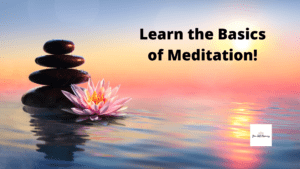
- Introduction to Meditation: Understanding the Basics
“Through meditation, we embark on a journey within, unraveling the mysteries of the mind and discovering the boundless depths of our being.”
Meditation is a practice that dates back thousands of years and is found in various cultures and spiritual traditions worldwide. At its core, meditation is a technique for training the mind and cultivating a state of focused awareness, presence, and inner calm. It involves directing one’s attention inward, away from external distractions, and towards the present moment.
The practice of meditation typically involves sitting comfortably in a quiet space, closing the eyes, and engaging in specific techniques to quiet the mind and deepen awareness. These techniques can vary widely and may include focused attention on the breath, repeating a mantra or sacred word, visualizing images or symbols, or simply observing thoughts and sensations as they arise without judgment.
The primary goal of meditation is to cultivate a state of mindfulness, which involves being fully present and engaged in the here and now, without attachment to past regrets or future worries. Through regular practice, individuals develop greater clarity of mind, emotional resilience, and a deeper connection with themselves and the world around them.
While the benefits of meditation are numerous and well-documented, it’s essential to approach the practice with an open mind and a spirit of curiosity. Meditation is not about achieving a specific outcome or attaining a particular state of consciousness; rather, it’s about embracing the journey of self-discovery and inner exploration with compassion and non-judgment.
Meditation is a simple yet profound practice that offers a gateway to inner peace, clarity, and self-awareness. By understanding the basics of meditation and incorporating it into daily life, individuals can experience a profound transformation in their mental, emotional, and spiritual well-being.
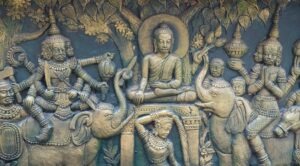
- The History and Evolution of Meditation Practices
“Meditation, born from ancient wisdom, evolves through time, guiding humanity towards inner peace and spiritual awakening, bridging the past with the present, and illuminating the path to a harmonious future.”
Meditation is an ancient practice that has evolved over thousands of years and has roots in various cultures and spiritual traditions around the world. Its history is rich and diverse, reflecting the human quest for inner peace, self-discovery, and spiritual enlightenment.
The origins of meditation can be traced back to ancient civilizations such as India, China, and Egypt, where it was often practiced as a means of connecting with the divine, achieving higher states of consciousness, and gaining insight into the nature of reality. In India, for example, meditation was integral to the spiritual teachings of Hinduism and Buddhism, with ancient texts such as the Vedas and Upanishads providing guidance on meditative practices.
Throughout history, meditation has undergone various transformations and adaptations as it spread to different cultures and civilizations. In China, Taoist practitioners developed qigong and tai chi as moving meditations, emphasizing the cultivation of energy (qi) and harmonizing the mind, body, and spirit. In Japan, Zen Buddhism emphasized seated meditation (zazen) as a means of attaining enlightenment and awakening to one’s true nature.
In the West, meditation gained popularity in the 20th century with the introduction of mindfulness practices derived from Buddhist teachings. Mindfulness meditation, which involves paying attention to the present moment with openness and curiosity, has been widely studied and adopted in secular contexts such as healthcare, education, and psychology.
In recent years, meditation has experienced a resurgence in popularity, fueled in part by scientific research highlighting its numerous health benefits, including stress reduction, improved cognitive function, and enhanced emotional well-being. Today, meditation is practiced by millions of people around the world, with a growing recognition of its potential to promote holistic wellness and spiritual growth.
The history and evolution of meditation practices reflect humanity’s enduring quest for inner peace, self-discovery, and spiritual awakening. From its ancient roots to its modern-day applications, meditation continues to inspire and empower individuals on their journey of personal and collective transformation.

- Exploring Different Meditation Techniques
“Within the vast landscape of meditation techniques lies a treasure trove of practices, each offering a unique pathway to inner peace, self-discovery, and spiritual growth, inviting us to explore the depths of our consciousness with curiosity and openness.”
Meditation encompasses a wide range of techniques, each with its unique approach and focus. These techniques have evolved over centuries and are rooted in various cultural and spiritual traditions. Exploring different meditation techniques allows individuals to find the practices that resonate most deeply with their needs, preferences, and spiritual beliefs. Here are some common meditation techniques:
- Mindfulness Meditation: Mindfulness meditation involves paying attention to the present moment without judgment. Practitioners focus their awareness on their breath, bodily sensations, thoughts, and emotions as they arise, cultivating a sense of presence and acceptance.
- Concentration Meditation: Concentration meditation involves focusing the mind on a single point of attention, such as the breath, a mantra, or a visual object. The goal is to develop concentration and mental clarity, allowing distractions to fall away and the mind to become more focused and calm.
- Loving-Kindness Meditation: Loving-kindness meditation, also known as Metta meditation, involves cultivating feelings of love, compassion, and goodwill towards oneself and others. Practitioners repeat phrases or intentions of loving-kindness, directing positive energy towards themselves, loved ones, acquaintances, and even difficult individuals.
- Transcendental Meditation (TM): Transcendental Meditation is a specific form of mantra meditation that involves silently repeating a specific mantra chosen for each individual. TM practitioners typically practice for 20 minutes twice daily, aiming to transcend ordinary waking consciousness and access deeper states of awareness.
- Guided Meditation: Guided meditation involves following the verbal guidance of a teacher or recorded audio to lead practitioners through a specific meditation practice. These guided sessions often include visualization, relaxation techniques, and prompts for self-reflection.
- Body Scan Meditation: Body scan meditation involves systematically bringing attention to different parts of the body, starting from the toes and moving upwards to the crown of the head. Practitioners observe sensations, tensions, and areas of discomfort, cultivating awareness and relaxation.
- Walking Meditation: Walking meditation is a mindfulness practice that involves walking slowly and deliberately while bringing attention to each step, the sensations of movement, and the surrounding environment. It can be practiced indoors or outdoors and offers an opportunity to integrate mindfulness into daily life.
These are just a few examples of the many meditation techniques available. Each technique offers unique benefits and can be adapted to suit individual preferences and goals. Exploring different meditation techniques allows individuals to deepen their practice, cultivate greater self-awareness, and experience the transformative power of meditation in their lives.

- Benefits of Meditation for Mind, Body, and Spirit
“Meditation, the sacred art of stillness, bestows upon us the gift of harmony, nurturing the mind, invigorating the body, and awakening the spirit, guiding us towards a state of wholeness and well-being.”
Meditation offers a wide range of benefits for overall well-being, encompassing the realms of mind, body, and spirit. Here’s a closer look at how meditation can positively impact each of these aspects:
1. Mind:
-
- Reduced Stress: Meditation is known to reduce levels of cortisol, the stress hormone, leading to greater relaxation and a sense of calm.
- Improved Focus and Concentration: Regular meditation practice strengthens the attentional circuits of the brain, enhancing focus, concentration, and cognitive function.
- Enhanced Emotional Regulation: Meditation cultivates awareness of thoughts and emotions, enabling individuals to respond to challenges with greater clarity and equanimity.
- Reduced Symptoms of Anxiety and Depression: Studies have shown that meditation can alleviate symptoms of anxiety and depression by promoting emotional resilience and a positive outlook on life.
2. Body:
-
- Lower Blood Pressure: Meditation has been linked to reductions in blood pressure, helping to protect against hypertension and cardiovascular disease.
- Strengthened Immune System: Meditation supports immune function by reducing inflammation and enhancing the body’s ability to fight off illness and infection.
- Pain Management: Meditation can alleviate chronic pain conditions by modulating pain perception and promoting relaxation of tense muscles.
- Better Sleep: Meditation promotes relaxation and reduces arousal, making it easier to fall asleep and improving overall sleep quality.
3. Spirit:
-
- Increased Self-Awareness: Meditation deepens self-awareness and fosters a greater understanding of one’s inner thoughts, emotions, and beliefs.
- Connection with Higher Consciousness: Meditation provides a pathway for connecting with higher states of consciousness, facilitating spiritual growth and inner transformation.
- Cultivation of Compassion and Loving-Kindness: Meditation practices such as loving-kindness meditation cultivate feelings of compassion, empathy, and goodwill towards oneself and others.
- Sense of Inner Peace and Fulfillment: Regular meditation practice leads to a profound sense of inner peace, contentment, and fulfillment, transcending the ups and downs of external circumstances.
The benefits of meditation are multifaceted and profound, offering holistic support for mind, body, and spirit. By incorporating meditation into daily life, individuals can experience greater resilience, vitality, and harmony in all aspects of their being.
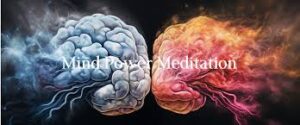
- The Science Behind Meditation: How It Impacts Brain and Body
“Meditation, the sacred art of stillness, bestows upon us the gift of harmony, nurturing the mind, invigorating the body, and awakening the spirit, guiding us towards a state of wholeness and well-being.”
Meditation has gained widespread attention in scientific research due to its profound effects on the brain and body. Through neuroimaging studies, physiological measurements, and clinical trials, scientists have uncovered the mechanisms by which meditation influences various aspects of brain function and physical health.
1. Brain Changes:
-
- Structural Changes: Meditation has been found to induce structural changes in the brain, including increased gray matter density in regions associated with memory, learning, and emotional regulation, such as the hippocampus and prefrontal cortex.
- Functional Connectivity: Meditation enhances functional connectivity between brain regions involved in attention, self-awareness, and emotional processing, leading to improvements in cognitive function and emotional well-being.
- Neuroplasticity: Meditation promotes neuroplasticity, the brain’s ability to reorganize and form new neural connections in response to experience, supporting learning, memory, and adaptive behavior.
2. Emotional Regulation:
-
- Stress Reduction: Meditation reduces activity in the amygdala, the brain’s fear center, and dampens the body’s stress response, leading to lower levels of cortisol and greater emotional resilience.
- Regulation of Emotions: Meditation enhances the brain’s capacity for emotional regulation by strengthening connections between the prefrontal cortex and limbic system, allowing individuals to respond to emotions with greater clarity and equanimity.
- Increased Positive Emotions: Meditation cultivates positive emotions such as compassion, gratitude, and joy, leading to greater overall happiness and well-being.
3. Physical Health:
-
- Immune Function: Meditation has been shown to boost immune function by reducing inflammation and increasing the activity of immune cells, helping to protect against illness and infection.
- Cardiovascular Health: Meditation lowers blood pressure, reduces heart rate, and improves circulation, leading to better cardiovascular health and a reduced risk of heart disease.
- Pain Management: Meditation alleviates chronic pain conditions by modulating pain perception and activating brain regions involved in pain relief, offering a natural and non-invasive approach to pain management.
4. Cognitive Function:
-
- Attention and Concentration: Meditation enhances attentional control and sustained focus by strengthening the brain’s attentional networks, leading to improvements in cognitive performance and productivity.
- Memory and Learning: Meditation improves memory consolidation and learning by promoting neuroplasticity and enhancing synaptic connectivity in memory-related brain regions, such as the hippocampus and prefrontal cortex.
The science behind meditation highlights its profound effects on the brain and body, offering insights into how this ancient practice promotes physical health, emotional well-being, and cognitive function. By incorporating meditation into daily life, individuals can harness these benefits to cultivate resilience, vitality, and inner peace.

- Cultivating Mindfulness: Practical Tips for Daily Life
“In the rhythm of daily life, mindfulness becomes our gentle guide, offering practical wisdom to cultivate presence, awaken awareness, and infuse each moment with grace, turning ordinary moments into extraordinary treasures.”
Mindfulness is the practice of being fully present and engaged in the present moment, with openness, curiosity, and acceptance. It involves paying deliberate attention to our thoughts, feelings, bodily sensations, and surroundings without judgment. Cultivating mindfulness in daily life can lead to greater clarity, peace, and well-being. Here are some practical tips for integrating mindfulness into your daily routine:
- Start with Mindful Breathing: Take a few moments throughout the day to focus on your breath. Notice the sensation of the breath as it enters and leaves your body. Allow your breath to anchor you in the present moment, bringing your attention back whenever you feel distracted or overwhelmed.
- Practice Mindful Eating: When eating, pay attention to the colors, textures, and flavors of your food. Chew slowly and savor each bite, noticing the sensations of taste, smell, and touch. Be fully present with the experience of eating, without multitasking or distractions.
- Take Mindful Breaks: Throughout the day, carve out moments for short mindfulness breaks. Pause for a few minutes to check in with yourself, notice how you’re feeling, and bring your awareness to your surroundings. Use these breaks as opportunities to reset and recharge.
- Engage in Mindful Movement: Incorporate mindful movement practices such as yoga, tai chi, or walking meditation into your routine. Pay attention to the sensations in your body as you move, and focus on the rhythm of your breath. Allow movement to become a form of meditation in motion.
- Practice Gratitude: Cultivate an attitude of gratitude by reflecting on the things you appreciate in your life. Take time each day to notice and acknowledge the blessings, big and small, that surround you. This practice can help shift your focus from negativity to positivity.
- Use Mindfulness Apps or Resources: Utilize mindfulness apps or online resources to support your practice. There are many guided meditations, mindfulness exercises, and relaxation techniques available that can help you cultivate mindfulness in your daily life.
- Be Kind to Yourself: Remember that mindfulness is a practice, and it’s okay to have moments of struggle or distraction. Approach yourself with kindness and compassion, and gently bring your attention back to the present moment whenever you notice your mind wandering.
By incorporating these practical tips into your daily life, you can cultivate greater mindfulness and presence, leading to increased clarity, peace, and well-being in all aspects of your life.

- Meditation and Emotional Well-Being: Managing Stress and Anxiety
“In the sanctuary of meditation, we find solace amidst life’s storms, as it becomes the anchor that steadies our ship through turbulent seas, guiding us towards emotional well-being, where stress and anxiety surrender to the tranquility of inner peace.”
Meditation is a powerful tool for managing stress and anxiety, offering a natural and effective approach to promoting emotional well-being. Through regular meditation practice, individuals can cultivate greater resilience, calm, and inner peace in the face of life’s challenges. Here’s how meditation can help manage stress and anxiety:
- Stress Reduction: Meditation activates the body’s relaxation response, triggering physiological changes that counteract the stress response. By focusing on the present moment and quieting the mind, meditation helps lower levels of cortisol, the stress hormone, leading to a reduction in overall stress levels.
- Emotional Regulation: Meditation enhances emotional regulation by increasing awareness of thoughts, feelings, and bodily sensations. Practitioners learn to observe their emotions without judgment and to respond to them with greater clarity and equanimity. This increased self-awareness allows individuals to break free from habitual patterns of reacting to stress and anxiety and to cultivate healthier coping strategies.
- Relaxation Response: Meditation induces a state of deep relaxation, characterized by slower breathing, reduced heart rate, and decreased muscle tension. This relaxation response counteracts the physiological symptoms of stress and anxiety, promoting a sense of calm and tranquility in both mind and body.
- Mindfulness-Based Stress Reduction (MBSR): MBSR is a structured program that combines mindfulness meditation with cognitive-behavioral techniques to help individuals manage stress, anxiety, and other psychological symptoms. Through guided meditation practices, body scans, and mindful movement exercises, participants learn to cultivate present-moment awareness and respond to stressors with greater resilience.
- Cognitive Restructuring: Meditation can help individuals reframe negative thought patterns and beliefs that contribute to stress and anxiety. By observing their thoughts without attachment, practitioners gain perspective on their cognitive distortions and develop a more balanced and compassionate relationship with their inner dialogue.
- Increased Resilience: Regular meditation practice strengthens the brain’s resilience to stress by promoting neuroplasticity, the brain’s ability to adapt and reorganize in response to experience. This enhanced resilience allows individuals to bounce back more quickly from adversity and to maintain a sense of well-being even in challenging circumstances.
Overall, meditation offers a holistic approach to managing stress and anxiety, addressing the root causes of emotional distress while promoting greater resilience, balance, and well-being. By incorporating meditation into daily life, individuals can cultivate a deeper sense of calm, clarity, and peace amidst the ups and downs of life’s journey.

- Deepening Your Practice: Advanced Meditation Techniques
“Embark on the journey of deepening your practice, where the gentle whispers of silence reveal hidden realms within, unveiling advanced meditation techniques that invite you to explore the boundless depths of consciousness and awaken to the infinite potential of your being.”
As individuals progress in their meditation journey, they may seek to deepen their practice by exploring advanced meditation techniques. These techniques build upon foundational practices and offer opportunities for greater insight, concentration, and spiritual growth. Here are some advanced meditation techniques to consider:
- Vipassana Meditation: Vipassana, or insight meditation, is a traditional Buddhist practice that involves observing the impermanent nature of all phenomena with mindfulness and equanimity. Practitioners cultivate a deep awareness of bodily sensations, thoughts, and emotions, developing insight into the nature of reality and the true nature of self.
- Samatha Meditation: Samatha, or tranquility meditation, is a practice focused on cultivating single-pointed concentration and mental tranquility. Practitioners typically choose a meditation object, such as the breath or a visual image, and train their minds to remain focused on that object to the exclusion of all else. This practice leads to states of deep absorption (jhana) characterized by profound stillness and bliss.
- Loving-Kindness Meditation: Loving-kindness meditation, also known as Metta meditation, involves cultivating feelings of love, compassion, and goodwill towards oneself and others. Practitioners repeat phrases or intentions of loving-kindness, directing positive energy towards themselves, loved ones, acquaintances, and even difficult individuals. This practice fosters a sense of interconnectedness and universal love.
- Tonglen Meditation: Tonglen is a Tibetan Buddhist practice that involves giving and receiving meditation. Practitioners visualize taking in the suffering of others on the in-breath and sending out healing and compassion on the out-breath. This practice cultivates empathy, compassion, and the recognition of our interconnectedness with all beings.
- Dzogchen Meditation: Dzogchen, or “Great Perfection,” is a form of meditation found in Tibetan Buddhism that emphasizes recognizing the inherent nature of mind (rigpa) as pristine awareness. Practitioners learn to rest in a state of non-conceptual awareness, free from grasping and fixation, and to recognize the luminous clarity of their true nature.
- Koan Practice: Koan practice is a Zen meditation technique that involves contemplating paradoxical statements or questions (koans) as a means of transcending dualistic thinking and accessing deeper levels of insight. Practitioners work with a Zen teacher to explore the meaning of koans and to experience moments of satori, or sudden enlightenment.
These are just a few examples of advanced meditation techniques that practitioners may explore to deepen their practice. Each technique offers a unique pathway to self-discovery, spiritual growth, and awakening, and individuals may find that certain practices resonate more deeply with their temperament and aspirations. As with any meditation practice, it’s essential to approach advanced techniques with patience, openness, and a spirit of inquiry.

- Transformational Breathing Techniques & Practice
“Through the rhythm of breath, we unlock the gateway to transformation, as each inhale and exhale becomes a sacred dance, guiding us to the depths of our essence, where healing and renewal await in the embrace of conscious breathing.”
Transformational breathing refers to a set of breathing techniques and practices designed to promote healing, self-discovery, and personal transformation. These techniques are rooted in the understanding that the breath is a powerful tool for accessing deeper levels of awareness, releasing emotional blockages, and facilitating physical, mental, and spiritual well-being. Here’s a closer look at transformational breathing techniques and how they work:
- Conscious Breathing: Conscious breathing involves bringing awareness to the breath and consciously altering its rhythm, depth, and pattern. By focusing on the breath and intentionally slowing down and deepening it, individuals can activate the body’s relaxation response, reduce stress, and promote a sense of calm and relaxation.
- Circular Breathing: Circular breathing is a technique used in various spiritual traditions and practices, such as meditation, yoga, and breathwork. It involves maintaining a continuous, unbroken flow of breath by inhaling and exhaling in a circular pattern, without pauses or gaps between breaths. This technique helps to balance the flow of energy in the body, increase oxygenation, and induce states of expanded awareness and consciousness.
- Connected Breathing: Connected breathing, also known as continuous or conscious connected breathing, involves breathing in a rhythmic, cyclical pattern without pausing between inhalation and exhalation. This technique encourages the body to release tension, emotional blockages, and trauma stored in the cellular memory, allowing for deep healing and transformation to occur.
- Breathwork Practices: Breathwork practices encompass a wide range of techniques and modalities that use the breath as a tool for personal growth and healing. These practices may include specific breathing patterns, guided visualizations, sound healing, and movement exercises designed to facilitate deep relaxation, emotional release, and spiritual awakening.
- Holotropic Breathwork: Holotropic breathwork is a powerful therapeutic technique developed by psychiatrist Dr. Stanislav Grof that involves intense, rapid breathing combined with evocative music and bodywork. This technique induces altered states of consciousness, allowing individuals to access deep levels of the psyche, repressed memories, and spiritual insights for healing and integration.
- Integrative Breathwork: Integrative breathwork combines elements of various breathwork modalities, such as rebirthing, shamanic breathwork, and somatic experiencing, to create a holistic approach to healing and transformation. Practitioners work with clients to tailor breathwork sessions to their specific needs, goals, and intentions, facilitating deep healing and personal growth.
Transformational breathing techniques and practices offer a powerful pathway to self-discovery, healing, and personal transformation. By working with the breath as a catalyst for change, individuals can access deeper levels of awareness, release emotional blockages, and unlock their full potential for health, happiness, and well-being.

- Overcoming Common Challenges in Meditation
“In the stillness of meditation, challenges arise as gentle teachers, guiding us to confront the turbulence within, yet through patience and persistence, we find our way back to the calm center, where peace reigns and obstacles dissolve into the vast expanse of awareness.”
Meditation is a transformative practice that offers numerous benefits for mental, emotional, and spiritual well-being. However, like any skill, it can present challenges for practitioners, especially those who are new to the practice. Some common challenges in meditation include difficulty concentrating, restlessness, physical discomfort, and resistance to uncomfortable thoughts or emotions.
One of the most common challenges in meditation is maintaining focus and concentration. It’s natural for the mind to wander, and practitioners may find themselves easily distracted by thoughts, sounds, or sensations. To overcome this challenge, it can be helpful to gently bring the focus back to the breath or another point of attention whenever the mind begins to wander. With practice, individuals can strengthen their ability to sustain attention and remain present in the moment.
Another challenge is restlessness or discomfort in the body. Sitting still for an extended period can lead to feelings of discomfort or agitation, especially for those who are not accustomed to sitting quietly. To address this challenge, practitioners can experiment with different meditation postures, such as sitting on a cushion or chair, lying down, or even practicing walking meditation. Additionally, incorporating gentle movement or stretching exercises before meditation can help release tension and create a more comfortable sitting experience.
Resistance to uncomfortable thoughts or emotions is another common challenge in meditation. When difficult thoughts or emotions arise during meditation, it’s natural to want to avoid or suppress them. However, mindfulness teaches us to acknowledge and accept whatever arises in the present moment without judgment. Practitioners can cultivate a sense of curiosity and compassion towards their inner experience, allowing difficult thoughts and emotions to come and go without getting caught up in them.
Ultimately, overcoming common challenges in meditation requires patience, perseverance, and a willingness to meet whatever arises with openness and acceptance. By approaching these challenges with a spirit of curiosity and self-compassion, practitioners can deepen their meditation practice and reap the many benefits it has to offer for overall well-being.

- Meditation and Spiritual Growth: Connecting with Higher Consciousness
“In the sanctuary of meditation, we transcend the confines of the self, merging with the infinite expanse of higher consciousness, where the whispers of the divine guide us on a journey of spiritual growth, awakening the soul to its innate wisdom and eternal connection with the universe.”
Meditation has long been recognized as a powerful tool for spiritual growth and awakening, offering practitioners a direct pathway to connect with higher states of consciousness and deepen their understanding of the nature of reality. At its essence, meditation is about transcending the limitations of the egoic mind and tapping into a deeper dimension of awareness that transcends individual identity. Through the practice of meditation, individuals can cultivate a sense of inner stillness, presence, and connection to something greater than themselves.
One of the primary ways that meditation facilitates spiritual growth is by quieting the incessant chatter of the mind and creating space for inner silence and clarity. In this state of heightened awareness, individuals can experience moments of expanded consciousness and glimpse the interconnectedness of all things. This sense of unity and interconnectedness lies at the heart of many spiritual traditions and is often referred to as “oneness” or “unity consciousness.”
Moreover, meditation allows practitioners to access higher states of consciousness, such as states of deep peace, bliss, and transcendence. These states are characterized by a profound sense of interconnectedness, harmony, and love that transcends ordinary dualistic perceptions of reality. In these elevated states of consciousness, individuals may experience profound spiritual insights, mystical experiences, and a deep sense of connection to the divine or universal intelligence.
Furthermore, meditation can serve as a direct gateway to accessing higher dimensions of consciousness beyond the confines of time and space. Through practices such as visualization, guided meditation, and shamanic journeying, individuals can explore the realms of the subconscious mind, access spiritual guides and allies, and receive guidance and inspiration from higher sources of wisdom.
Meditation is a profound tool for spiritual growth and evolution, offering practitioners a direct pathway to connect with higher consciousness and awaken to the true nature of reality. By cultivating a regular meditation practice, individuals can deepen their spiritual awareness, expand their consciousness, and experience profound shifts in perception that lead to greater peace, joy, and fulfillment in life.

- Meditation in Action: Integrating Mindfulness into Daily Activities
“As we carry the torch of mindfulness into the bustling streets of daily life, each step becomes a sacred dance, each breath a gentle reminder to be present, weaving the fabric of our existence with the threads of awareness, turning every moment into a meditation in action.”
While formal meditation practice involves setting aside dedicated time to sit quietly and cultivate mindfulness, the essence of meditation extends beyond the cushion into everyday life. Meditation in action, or mindfulness in daily activities, involves bringing the same qualities of awareness, presence, and non-judgmental attention cultivated in formal meditation practice into all aspects of daily life. This means being fully engaged and present in each moment, whether it’s eating a meal, walking, washing dishes, or interacting with others.
Integrating mindfulness into daily activities begins with a shift in perspective, recognizing that every moment offers an opportunity for presence and awareness. Instead of viewing mundane tasks as mere chores or distractions, practitioners approach them as opportunities for mindfulness practice. For example, when eating a meal, one can bring full attention to the sensory experience of eating, savoring each bite and noticing the flavors, textures, and sensations in the body.
Another key aspect of meditation in action is cultivating a sense of embodied presence, grounding oneself in the present moment through awareness of the body and breath. This involves bringing attention to physical sensations, posture, and movement as we go about our daily activities. Whether walking, standing, or sitting, we can connect with the sensations of the body and the rhythm of the breath, anchoring ourselves in the present moment.
Furthermore, mindfulness in daily activities involves bringing a non-judgmental attitude to our experiences, accepting things as they are without resistance or attachment. This means letting go of the tendency to judge ourselves or others, and instead approaching each moment with openness, curiosity, and compassion. By letting go of expectations and embracing what is, we can cultivate greater peace, contentment, and joy in our lives.
Ultimately, meditation in action is about living each moment with intention, awareness, and presence, infusing our daily activities with mindfulness and creating opportunities for spiritual growth and transformation in every aspect of our lives. Through the practice of integrating mindfulness into daily activities, we can cultivate a deeper sense of connection, meaning, and fulfillment, and awaken to the richness and beauty of each moment.

- Building a Sustainable Meditation Practice: Creating Rituals and Routines
“In the sanctuary of daily rituals and routines, we lay the foundation for a sustainable meditation practice, weaving threads of intention and commitment into the fabric of our lives, nurturing the seeds of mindfulness to blossom into the garden of inner peace.”
Creating rituals and routines around meditation is essential for building a sustainable and consistent practice. A sustainable meditation practice involves establishing habits and structures that support regular meditation sessions and integrate mindfulness into daily life. Rituals and routines provide a framework for incorporating meditation into daily activities, making it easier to maintain a consistent practice over time. Here’s how creating rituals and routines can help build a sustainable meditation practice:
- Establishing a Regular Schedule: Setting aside dedicated time each day for meditation helps make it a priority in your life. Whether it’s first thing in the morning, during a lunch break, or before bed, choose a time that works best for you and stick to it consistently. By incorporating meditation into your daily schedule, it becomes a natural part of your routine.
- Designating a Sacred Space: Creating a dedicated meditation space can enhance the quality of your practice and provide a sense of sanctuary. Choose a quiet, comfortable area in your home where you can meditate without distractions. Decorate the space with items that inspire you, such as candles, incense, or meaningful symbols, and make it a sacred refuge for your practice.
- Establishing Rituals and Ceremonies: Rituals and ceremonies can add depth and meaning to your meditation practice, helping to anchor you in the present moment and create a sense of continuity. This could involve lighting a candle, reciting a mantra or prayer, or performing a symbolic gesture before beginning your meditation session. These rituals help signal to your mind and body that it’s time to transition into a state of mindfulness.
- Creating Accountability and Support Systems: Building a sustainable meditation practice often requires accountability and support from others. Consider joining a meditation group or online community where you can connect with like-minded individuals, share experiences, and receive guidance and encouragement. Accountability partners or meditation buddies can also help keep you accountable and motivated to maintain your practice.
- Integrating Mindfulness into Daily Activities: Beyond formal meditation sessions, find ways to integrate mindfulness into your daily routines and activities. This could involve practicing mindful eating, mindful walking, or bringing awareness to everyday tasks such as washing dishes or brushing your teeth. By infusing mindfulness into all aspects of your life, you cultivate a deeper sense of presence and awareness.
By creating rituals and routines around meditation, you provide structure and support for your practice, making it easier to cultivate mindfulness and sustain a regular meditation practice over the long term. With consistency and dedication, you can reap the numerous benefits of meditation and experience greater peace, clarity, and well-being in your life.

- Meditation for Health and Healing: Exploring Alternative Therapies
“Through the gentle embrace of meditation, we embark on a journey of healing, exploring the boundless terrain of our inner landscape, where the alchemy of breath and awareness becomes the elixir of health, nurturing the body, soothing the soul, and awakening the spirit to the innate wisdom of the healing journey.”
Meditation has gained recognition as a valuable tool for promoting health and healing, offering a complementary approach to conventional medical treatments. While meditation is often associated with mental and emotional well-being, its benefits extend to physical health as well. Alternative therapies incorporating meditation aim to harness the body’s innate healing abilities and promote holistic wellness. These therapies include practices such as mindfulness-based stress reduction (MBSR), guided imagery, and relaxation response techniques.
Mindfulness-based stress reduction (MBSR), pioneered by Dr. Jon Kabat-Zinn, is one of the most widely researched and utilized meditation-based therapies for health and healing. MBSR combines mindfulness meditation, body awareness, and gentle yoga to help individuals manage stress, reduce symptoms of anxiety and depression, and improve overall well-being. By cultivating present-moment awareness and non-judgmental acceptance of one’s experience, MBSR empowers individuals to respond to physical and emotional challenges with greater resilience and equanimity.
Guided imagery is another alternative therapy that incorporates meditation principles to promote healing. In guided imagery sessions, individuals are led through visualization exercises designed to evoke relaxation, reduce pain, and stimulate the body’s natural healing processes. By engaging the imagination and creating positive mental images, guided imagery can help individuals tap into the mind-body connection and facilitate healing on a deep level.
Relaxation response techniques, inspired by the work of Dr. Herbert Benson, involve eliciting the body’s natural relaxation response through practices such as deep breathing, progressive muscle relaxation, and mindfulness meditation. These techniques counteract the body’s stress response, leading to reductions in blood pressure, heart rate, and muscle tension. By inducing a state of deep relaxation, relaxation response techniques promote healing and enhance overall health and well-being.
Meditation-based alternative therapies offer a holistic approach to health and healing, addressing the interconnectedness of mind, body, and spirit. By incorporating meditation into therapeutic interventions, individuals can harness the body’s innate healing abilities, reduce stress, and promote holistic wellness. As research continues to demonstrate the effectiveness of meditation for health and healing, these alternative therapies are becoming increasingly recognized as valuable tools for enhancing overall well-being and quality of life.
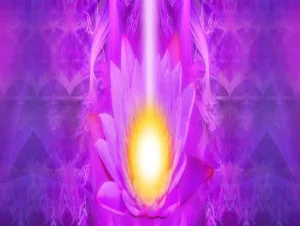
- Violet Flame Meditation Practice
“In the sacred embrace of the violet flame, we surrender to the alchemy of transformation, transmuting darkness into light, and awakening to the radiant essence of our being.”
Violet Flame Meditation Practice is a spiritual technique rooted in esoteric and metaphysical traditions, particularly within the teachings of the Ascended Masters. The violet flame is believed to be a powerful tool for spiritual purification, healing, and transformation. In this practice, individuals visualize and invoke the violet flame, a divine energy of transmutation, to cleanse and purify their energy field, release negative patterns, and elevate their consciousness.
During a violet flame meditation, practitioners typically enter into a relaxed state of consciousness, often through deep breathing or visualization techniques. They then visualize a violet flame, often described as a flickering flame or a stream of violet light, either surrounding their body or filling their entire being.
As the practitioner connects with the violet flame, they may also recite affirmations or mantras associated with transmutation and purification, such as “I am a being of violet fire, I am the purity God desires” or “I invoke the violet flame to transmute all negativity into love, light, and divine harmony.”
The violet flame is believed to have the power to transform negative energies, such as fear, anger, and resentment, into positive qualities, such as love, compassion, and forgiveness. By invoking the violet flame, practitioners seek to release emotional baggage, clear karmic patterns, and align with their highest spiritual potential.
Furthermore, the violet flame is said to have a cleansing and purifying effect on the physical, emotional, mental, and spiritual levels, promoting healing and balance in all aspects of life. Through regular practice, individuals may experience greater clarity, vitality, and spiritual growth.
The Violet Flame Meditation Practice offers a powerful and transformative tool for those seeking spiritual purification, healing, and self-transformation. It is a practice rooted in the belief that by harnessing the divine energy of the violet flame, individuals can release negativity, elevate their consciousness, and align with their highest spiritual potential.

- The Role of Meditation in Personal Transformation
“Meditation, the silent alchemist of personal transformation, gently nudges us to shed the layers of illusion, revealing the radiant truth of our being, as we surrender to the rhythm of our breath and the stillness within, becoming architects of our own evolution.”
Meditation serves as a powerful catalyst for personal transformation, offering individuals a pathway to deepen self-awareness, cultivate inner peace, and unlock their full potential. At its core, meditation is a practice of self-exploration and self-discovery, inviting individuals to journey inward and explore the depths of their consciousness. Through regular meditation practice, individuals can gain insight into their thoughts, emotions, and habitual patterns of behavior, leading to profound shifts in perspective and personal growth.
One of the key ways that meditation facilitates personal transformation is by fostering greater self-awareness. Through mindfulness meditation, individuals learn to observe their thoughts and emotions without attachment or judgment, gaining clarity about the underlying patterns that shape their experiences and behaviors. This heightened self-awareness allows individuals to break free from unconscious conditioning and make conscious choices aligned with their values and aspirations.
Furthermore, meditation cultivates a sense of inner peace and equanimity, even in the midst of life’s challenges and uncertainties. By developing a stable anchor in the present moment, individuals learn to navigate difficult emotions and situations with greater resilience and grace. This inner resilience enables individuals to respond to life’s ups and downs with greater calmness, clarity, and confidence, fostering emotional well-being and psychological resilience.
Moreover, meditation opens the door to profound spiritual insights and experiences, allowing individuals to connect with a deeper dimension of reality beyond the confines of the egoic mind. Through practices such as mindfulness, loving-kindness, and transcendental meditation, individuals can access states of expanded consciousness, unity, and interconnectedness with all of life. These spiritual experiences often catalyze profound shifts in perspective and identity, leading to a greater sense of purpose, meaning, and fulfillment in life.
The role of meditation in personal transformation is multifaceted and profound. By cultivating self-awareness, inner peace, and spiritual insight, meditation empowers individuals to transcend limitations, embrace their full potential, and live authentically from the heart. As individuals continue to engage in regular meditation practice, they embark on an ongoing journey of self-discovery, growth, and evolution, leading to a deeper sense of connection, fulfillment, and wholeness in life.

- Meditation Communities and Resources: Finding Support and Guidance
“In the embrace of meditation communities and resources, we find a sanctuary of shared intention and collective wisdom, where the echoes of silence and the whispers of insight guide us on our journey inward, illuminating the path with the warmth of community and the guidance of shared practice.”
Engaging with meditation communities and resources can significantly enhance one’s meditation practice by providing support, guidance, and a sense of belonging. In today’s interconnected world, there are numerous opportunities to connect with like-minded individuals and access a wealth of resources to support meditation practice. Meditation communities can take various forms, including local meditation groups, online forums, retreat centers, and spiritual centers. These communities offer opportunities for practitioners to share experiences, receive guidance from experienced teachers, and cultivate a sense of community and belonging.
Online meditation communities and resources have become increasingly popular, offering accessible and convenient options for practitioners to connect and learn from each other. Online forums, social media groups, and meditation apps provide platforms for practitioners to share insights, ask questions, and access guided meditations and teachings from experienced teachers. These online communities offer a sense of connection and support, even for those who may not have access to local meditation groups or teachers.
Additionally, meditation retreats and workshops offer immersive experiences for practitioners to deepen their practice and connect with a supportive community of like-minded individuals. Retreats provide an opportunity to step away from the distractions of daily life, immerse oneself in meditation practice, and receive guidance from experienced teachers. Whether it’s a weekend retreat or a longer residential program, retreats offer a transformative space for personal growth, self-discovery, and spiritual renewal.
Moreover, meditation resources such as books, podcasts, and online courses provide valuable guidance and inspiration for practitioners at all levels. These resources cover a wide range of topics, including meditation techniques, mindfulness practices, and teachings from various spiritual traditions. By exploring different resources and teachings, practitioners can deepen their understanding of meditation and find approaches that resonate with their unique needs and preferences.
Meditation communities and resources play a crucial role in supporting and enhancing one’s meditation practice. Whether it’s connecting with local meditation groups, engaging with online communities, attending retreats, or exploring meditation resources, practitioners have access to a wealth of support and guidance to help them on their meditation journey. By actively engaging with meditation communities and resources, practitioners can cultivate a sense of connection, inspiration, and growth in their practice.

- Meditation for Divine Feminine
“In the sacred space of meditation, we honor the divine feminine within, as we embrace the gentle power of intuition, nurture the seeds of compassion, and dance with the rhythms of creation, awakening to the infinite depths of our soul’s wisdom and the boundless love that flows through us.”
Meditation for the Divine Feminine is a sacred journey that invites individuals to honor and nurture the qualities traditionally associated with the feminine aspect of divinity. By tapping into qualities like nurturing, intuition, compassion, creativity, and receptivity, practitioners establish a profound connection with the feminine aspects of the divine.
Through various meditation techniques, individuals cultivate these qualities within themselves, fostering a deeper connection with the feminine aspect of divinity. Techniques such as heart-centered meditations and visualization exercises enable practitioners to embrace compassion, empathy, and connect with archetypal feminine figures like goddesses or mother earth.
Through Divine Feminine Meditation, individuals delve inward, guided by love and inner freedom, trusting their intuition and discerning when to take action. This involves promoting self-love, self-care, trust, faith, and acceptance. Embracing our inherent feminine nature, irrespective of gender, facilitates the restoration of balance between these energies, ushering in harmony and alignment in our lives.
Ultimately, meditation for the Divine Feminine is a deeply personal and transformative practice that invites individuals (regardless of gender) to connect with the feminine aspects of themselves and the divine. By embracing and embodying these qualities, practitioners can cultivate greater balance, harmony, and wholeness in their lives, as well as contribute to the collective awakening of the Divine Feminine energy on the planet.

- Solar Eclipse & Astrological Alignment Meditation
“As the cosmic dance of the solar eclipse and celestial alignments unfold, we enter the sacred realm of meditation, where the energies of the heavens converge with the depths of our being, guiding us to awaken to the wisdom of the stars and the timeless rhythms of the universe.”
Solar eclipses are potent celestial events that occur when the moon passes between the Earth and the Sun, temporarily obscuring the Sun’s light. In astrology, solar eclipses are considered powerful moments for transformation, as they often coincide with significant shifts in energy and consciousness. During a solar eclipse, the alignment of celestial bodies can amplify the effects of meditation and spiritual practices, making it an opportune time for deep introspection, manifestation, and alignment with cosmic energies.
Astrological alignment meditation during a solar eclipse involves harnessing the heightened energies of the eclipse to align with one’s intentions, desires, and spiritual goals. Practitioners may choose to meditate during the peak of the eclipse, focusing their attention on the energy of the Sun, Moon, and Earth, and the astrological significance of the event. Visualization techniques may be used to imagine oneself surrounded by the transformative energies of the eclipse, allowing them to permeate every aspect of their being.
During this meditation, practitioners may set intentions for personal growth, healing, and spiritual evolution, using the energy of the eclipse to amplify their intentions and manifest their desires. They may also seek guidance from their higher selves, spirit guides, or the universe, asking for clarity, wisdom, and direction on their spiritual path.
Additionally, practitioners may choose to work with specific astrological aspects or planetary energies that are activated during the eclipse, such as the position of the Sun, Moon, and other celestial bodies in the zodiac. By attuning to these energies, practitioners can align themselves with the cosmic rhythms and cycles of the universe, fostering greater harmony, balance, and alignment in their lives.
This solar eclipse and astrological alignment meditation offer a powerful opportunity for spiritual growth, transformation, and alignment with cosmic energies. By harnessing the potent energies of the eclipse and working with the astrological influences of the moment, practitioners can deepen their meditation practice, accelerate their spiritual evolution, and manifest their highest potential.

The Effects of Mass Meditations: Uniting Hearts, Amplifying Intentions, and Shaping Collective Consciousness
“In the collective dance of mass meditations, hearts unite, intentions amplify, and the tapestry of collective consciousness is woven with threads of harmony, peace, and transformative energy.”

- Intuitive Science of Remote Viewing
“In the intuitive science of remote viewing, we transcend the boundaries of space and time, merging the realms of intuition and exploration, as we navigate the unseen landscapes of consciousness and uncover the hidden mysteries of existence.”
Remote viewing is a practice that involves using extrasensory perception (ESP) or psychic abilities to perceive or “view” information about a distant or unseen target. It is often considered a form of psi (psychic) phenomenon and has been studied extensively in the field of parapsychology. The intuitive science of remote viewing combines elements of intuition, psychic perception, and scientific methodology to explore the nature and potential of human consciousness.
In remote viewing, individuals typically enter a relaxed state of consciousness and use techniques such as meditation or visualization to access information beyond their ordinary senses. They may then “view” or perceive details about a target location, person, or event, often describing their impressions in the form of images, sensations, or impressions. Remote viewing sessions are often conducted under controlled conditions to minimize external influences and ensure the validity of the results.
The intuitive aspect of remote viewing involves tapping into one’s intuitive or psychic abilities to access information that is not accessible through conventional means. This may involve tuning into subtle energy fields, accessing the collective unconscious, or connecting with higher levels of consciousness. Remote viewers often rely on their intuition to guide them in interpreting the information they receive and distinguishing between genuine impressions and mental noise.
At the same time, remote viewing also incorporates scientific principles and methodologies to study and validate its effectiveness. Researchers have conducted numerous experiments and studies to investigate the phenomenon of remote viewing, exploring factors such as accuracy, reliability, and reproducibility. While the results of remote viewing experiments have been mixed, some studies have reported statistically significant results, suggesting that remote viewing may indeed have some basis in reality.
The intuitive science of remote viewing seeks to bridge the gap between intuition and scientific inquiry, exploring the potential of human consciousness to transcend the limits of space and time. By combining intuitive insights with rigorous scientific investigation, researchers hope to gain a deeper understanding of the nature of consciousness and its relationship to the physical world.

- The Art of Conscious Bi-Location
“The art of conscious bi-location invites us to transcend the limitations of physicality, as we dance between worlds with grace and intention, embracing the boundless expanse of consciousness and exploring the infinite possibilities of existence.”
The Art of Conscious Bi-Location refers to the ability to be present or consciously aware in two or more locations simultaneously, regardless of physical distance. This concept is often associated with mystical or spiritual traditions, where practitioners claim to be able to project their consciousness to distant places while remaining aware of their physical surroundings. Bi-location is considered a form of psychic phenomenon or altered state of consciousness, allowing individuals to transcend the limitations of ordinary perception and experience.
In the practice of conscious bi-location, individuals typically enter a deep state of meditation or altered consciousness, where they are able to dissociate their awareness from their physical body and project it to another location. This projection of consciousness may involve visualizing oneself in the desired location, sensing the surroundings, and experiencing events as if physically present. Practitioners often report feeling a sense of expansion or connection with the environment they are bi-locating to, as well as heightened sensory perception and intuitive insights.
The art of conscious bi-location is believed to require a high level of mastery over one’s consciousness and energy field, as well as a deep understanding of subtle energy dynamics and the nature of reality. It is often practiced by advanced meditators, mystics, and spiritual adepts who have dedicated years to honing their psychic abilities and expanding their consciousness.
While the concept of conscious bi-location may seem far-fetched to some, there are anecdotal reports and accounts of individuals who claim to have experienced this phenomenon. These accounts often come from spiritual or mystical traditions, where bi-location is seen as a manifestation of advanced spiritual attainment and divine grace.
In contemporary times, conscious bi-location is sometimes explored in the context of parapsychology and consciousness research, where scientists investigate the potential of human consciousness to transcend the limitations of space and time. However, empirical evidence for the phenomenon remains limited, and it is often regarded as a subjective experience that defies conventional scientific explanation.
The art of conscious bi-location remains a mysterious and elusive phenomenon that continues to fascinate spiritual seekers, mystics, and consciousness researchers alike. Whether viewed as a rare spiritual gift, a psychological phenomenon, or a glimpse into the nature of consciousness itself, bi-location challenges our understanding of the nature of reality and the potential of human consciousness.

- Metaphysical Astro-Travel
“Metaphysical astro-travel beckons us to journey beyond the confines of the known, as we transcend earthly bounds and traverse the cosmic expanse, exploring the realms of the stars with open hearts and awakened spirits.”
Metaphysical Astro-Travel, also known as astral projection or astral travel, is a phenomenon where an individual consciously separates their consciousness or spirit from their physical body and explores other realms or dimensions beyond the physical plane. In metaphysical or esoteric traditions, such as mysticism and spirituality, it is believed that human consciousness can transcend the limitations of the physical body and journey to higher or alternate planes of existence.
During metaphysical astro-travel, practitioners often enter into a deep state of relaxation or meditation to achieve a heightened level of consciousness. From this altered state, they may experience sensations of floating or flying, and they perceive themselves as traveling through space or different dimensions. Some individuals report encountering spiritual beings, visiting otherworldly landscapes, or gaining profound insights about the nature of reality and existence.
Metaphysical astro-travel is closely associated with the concept of the astral plane, which is believed to be a dimension of reality that exists beyond the physical realm. According to metaphysical beliefs, the astral plane is inhabited by various entities, energies, and forms of consciousness, and it can be accessed through astral projection.
Practitioners of metaphysical astro-travel often use visualization techniques, meditation, or guided imagery to facilitate the experience. By focusing their intention and directing their consciousness, they aim to detach their astral body from their physical body and explore the astral realms.
While the phenomenon of metaphysical astro-travel is difficult to prove scientifically and is often regarded as a subjective experience, it has been practiced and documented in spiritual traditions around the world for centuries. Many individuals who engage in astral projection view it as a tool for spiritual growth, self-discovery, and expanding their understanding of the nature of reality and consciousness.

- Meditative ET Contact Protocols | CE-5 Contact
“Meditative ET Contact Protocols, or CE-5 Contact, illuminate the path to cosmic communion, as we harmonize with the universe’s symphony, inviting benevolent beings from distant stars to dance with us in the sacred space of consciousness.”
Meditative ET Contact Protocols are structured practices designed to facilitate contact or communication with extraterrestrial beings, often through meditation, altered states of consciousness, or telepathic communication. These protocols are based on the belief that advanced extraterrestrial civilizations may be able to communicate with humans through non-verbal or telepathic means, and that individuals can enhance their receptivity to such communication through meditation and focused intention.
The concept of Meditative ET Contact Protocols is rooted in various esoteric and spiritual traditions, as well as in the growing field of ufology and contactee experiences. Practitioners of these protocols often engage in specific meditation techniques or visualization exercises aimed at raising their vibrational frequency, expanding their consciousness, and opening themselves to contact with extraterrestrial beings.
One common element of Meditative ET Contact Protocols is the use of guided meditations or visualization exercises to create a receptive and welcoming space for contact. Participants may visualize themselves surrounded by light, send out thoughts of peace and goodwill, or imagine themselves making telepathic contact with friendly and benevolent extraterrestrial beings.
Another aspect of Meditative ET Contact Protocols involves setting clear intentions and creating a positive energetic field conducive to contact. This may involve practices such as chanting, toning, or using sacred symbols to amplify the energy and focus the intention of the participants.
Additionally, practitioners of Meditative ET Contact Protocols often engage in group meditation or coordinated events where individuals from around the world come together at a specific time to collectively send out their intentions for contact. These group meditations are believed to create a powerful energetic resonance that may increase the likelihood of contact with extraterrestrial beings.
The effectiveness of Meditative ET Contact Protocols is difficult to measure and verify empirically, many individuals who have engaged in these practices report profound and transformative experiences, including sightings of UFOs, encounters with non-human entities, and telepathic communication with extraterrestrial beings. Whether viewed as a spiritual practice, a form of consciousness exploration, or a means of initiating contact with advanced civilizations from beyond Earth, Meditative ET Contact Protocols continue to be a subject of interest and exploration for many individuals around the world.

ET Contact Key Components | Intuitive Meditation
“A Key Intention of Our Collective Close Encounter of the Fifth Kind”
ET Contact Protocols, also known as CE-5 (Close Encounter of the Fifth Kind) Contact, are structured methodologies aimed at establishing communication and interaction with extraterrestrial beings through meditation and conscious intention. Developed by Dr. Steven Greer, CE-5 protocols combine aspects of meditation, remote viewing, and telepathic communication to initiate peaceful contact with advanced extraterrestrial civilizations.
The CE-5 Protocols Involve Several Key Components:
- Preparation: Participants engage in meditation and relaxation techniques to quiet the mind, raise their vibrational frequency, and cultivate a state of inner peace and receptivity. This preparation phase is essential for creating an optimal energetic environment for contact.
- Intent: Participants set clear and positive intentions to establish peaceful and benevolent contact with extraterrestrial beings. Intentions may include expressing goodwill, curiosity, and openness to communication with non-human intelligences.
- Visualization: Participants engage in guided visualization exercises to create a mental image of contacting extraterrestrial beings. This visualization may involve imagining a peaceful encounter, sending out telepathic messages of welcome, and envisioning the presence of friendly extraterrestrial entities.
- Remote Viewing: Participants may also practice remote viewing techniques to perceive distant locations or communicate telepathically with extraterrestrial beings. Remote viewing is used to transcend the limitations of physical space and establish a connection with beings from other dimensions or planets.
- Group Meditation: CE-5 protocols often involve group meditation sessions where participants come together to collectively focus their intention and energy towards initiating contact with extraterrestrial civilizations. Group meditation is believed to amplify the energetic resonance and increase the likelihood of successful contact.
- Field Work: Participants may conduct CE-5 protocols in outdoor locations with minimal light pollution, such as remote wilderness areas or desert landscapes. Field work allows participants to observe the night sky, look for unidentified aerial phenomena (UAP), and potentially witness anomalous sightings or encounters.
Meditative ET Contact Protocols, or CE-5 Contact, represent a holistic approach to initiating peaceful communication and interaction with extraterrestrial civilizations. By combining meditation, intention setting, visualization, and group dynamics, practitioners aim to transcend the boundaries of space and establish a connection with beings from other worlds in a spirit of curiosity, cooperation, and friendship.
“Just watch this moment, without trying to change it at all. What is happening? What do you feel? What do you see? What do you hear?” – Jon Kabat-Zinn

DISCLAIMER: All statements, claims, views and opinions that appear anywhere on this site, whether stated as theories or absolute facts, are always presented by The Great Awakening Report (GAR) as unverified—and should be personally fact checked and discerned by you, the reader. Any opinions or statements herein presented are not necessarily promoted, endorsed, or agreed to by GAR, those who work with GAR, or those who read or subscribe to GAR. Any belief or conclusion gleaned from content on this site is solely the responsibility of you the reader to substantiate. Any actions taken by those who read material on this site are solely the responsibility of the acting party. You are encouraged to think for yourself and do your own research. Nothing on this site is meant to be believed without question or personal appraisal.
Copyright Disclaimer: Citation of articles and authors in this report does not imply ownership. Works and images presented here fall under Fair Use Section 107 and are used for commentary on globally significant newsworthy events. Under Section 107 of the Copyright Act 1976, allowance is made for fair use for purposes such as criticism, comment, news reporting, teaching, scholarship, and research.
Community Guidelines Disclaimer: The points of view and purpose of this video is not to bully or harass anybody, but rather share that opinion and thoughts with other like-minded individuals curious about the subject.

